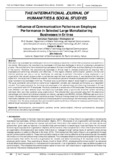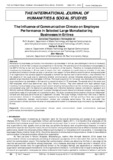Influence of Communication Patterns on Employee Performance in Selected Large Manufacturing Businesses in Eritrea
| dc.contributor.author | Weldeghebriel, Z. F. | |
| dc.contributor.author | Mberia, H. K. | |
| dc.contributor.author | Ndavula, John O. | |
| dc.date.accessioned | 2021-02-05T13:01:31Z | |
| dc.date.available | 2021-02-05T13:01:31Z | |
| dc.date.issued | 2019-05 | |
| dc.identifier.citation | THE INTERNATIONAL JOURNAL OF HUMANITIES & SOCIAL STUDIES, Vol 7 Issue 5 | en_US |
| dc.identifier.issn | 2321 - 9203 | |
| dc.identifier.uri | https://www.researchgate.net/publication/336768696_Influence_of_Communication_Patterns_on_Employee_Performance_in_Selected_Large_Manufacturing_Businesses_in_Eritrea | |
| dc.identifier.uri | http://hdl.handle.net/123456789/4511 | |
| dc.description.abstract | Manufacturing businesses face challenges in terms of increasing productivity in which their products are competitive in the market. Particularly, the manufacturing businesses in Eritrea face challenges in terms of producing a competitive product. The contribution of the manufacturing businesses in Eritrea to the GDP is low and thus affecting to the economy of the country. Therefore, the manufacturing businesses in Eritrea need to increase productivity by ensuring their employees are performing efficiently and effectively. In this regard, effective communication patterns (formal and informal patterns) can play a role by facilitating the exchange of pertinent information among employees in an organization that actually supports them to achieve the required level of performance. It was therefore that the main objective of this study was to determine whether communication patterns influence employee performance in selected large manufacturing businesses in Eritrea. This study was a quantitative research study based on a quantitative data. The study considered communication patterns as independent variable and employee performance as a dependent variable. The target population for this study was employees of the selected large manufacturing businesses in Eritrea with a population size of 4175 employees. The study considered a sample size of 365 employees. The sampled employees were selected from each selected large manufacturing businesses using proportionate stratified random sampling technique. Data was then collected using questionnaire. The collected data was analyzed using both the descriptive (percentage) and inferential statistical analysis (correlation, regression and ANOVA) methods. SPSS was used as a tool to conduct the descriptive and inferential statistical analysis. The study findings reveal that there was a significant positive relationship between communication patterns and employee performance although the relationship was not so strong. It is therefore that the study concluded that communication patterns did have influence on employee performance in the selected large manufacturing businesses in Eritrea. | en_US |
| dc.language.iso | en | en_US |
| dc.subject | Communication | en_US |
| dc.subject | communication patterns | en_US |
| dc.subject | formal communication | en_US |
| dc.subject | informal communication | en_US |
| dc.subject | employee performance | en_US |
| dc.subject | manufacturing businesses | en_US |
| dc.title | Influence of Communication Patterns on Employee Performance in Selected Large Manufacturing Businesses in Eritrea | en_US |
| dc.type | Article | en_US |



